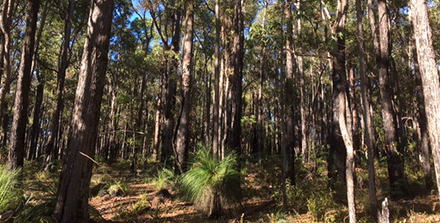
Regrowth jarrah forest south-east of Perth banned from harvesting by the McGowan government. This forest is ear-marked to be strip-mined for bauxite.
Those in the timber industry in Western Australia could easily be converted to the opinion that conspiracy theories do exist.
Take Gavin Butcher’s comment piece in today’s Daily Timber News.
Now, Mr Butcher is no newcomer to the timber industry in the west. He is a former director of the WA Forest Products Commission. So, his opinions carry a bit of weight.
He rather politely says that claims by Premier McGowan and his Forestry Ministers – Jackie Jarvis and previously Dave Kelly – that one of the reasons the native timber industry in that State had been axed was because the trees were no longer growing was “without substance”.
Very polite. The civility, if that word can be used, doesn’t last long.
“It’s time for the government to come clean and admit its decision to stop native forest harvesting was devoid of any science and simply a political play to appeal to its green fringe,” he says in conclusion.
Strong stuff indeed.
Cue Jack Bradshaw, again no slouch when it comes to the timber industry. He is a former manager of the Forest Management Branch of the Dept of Conservation and Land Management.
He says that despite evidence to the contrary, the WA Minister for Forests Jacki Jarvis continues to argue that the WA timber industry had to close because it has run out of wood as a result of reduced growth rate due to climate change, quoting reports from CSIRO and the Bureau of Meteorology as evidence.
Mr Bradshaw says neither of these organisations has any involvement in the determination of timber yield.
He says that in past Management Plans, specialist staff in the Department of Parks and Wildlife or its predecessors (now Department of Biodiversity, Conservation and Attractions) made estimates of sustainable yield allowing for contingencies such as wildfire, climate change or proposed tenure changes.
The data and methodology used were then reviewed by a panel of independent experts before a recommendation was made to government. This he says did not happen for the new management plan.
He says a freedom of information request asking what information had been provided to the government on the impact of climate change on timber yields produced no information relating to changes in growth rate or yield over time and no information at all relating to karri.
Access to one third of relevant documents were refused on the grounds that “its disclosure would reveal any deliberation or decision made by an Executive body” ie the public is not entitled to know what information the government uses to make its decisions.
So much for open government, says Mr Bradshaw.
“Either DBCA were told not to bother determining the yield for this management plan or the calculated yield did not suit the government’s pre-determined decision to close the industry. There was no review by an independent panel.
“Despite the fact the biggest change to be made to forest management in last 170 years was the closure of the timber industry, it is not even mentioned until page 32 of the Draft and without a single reason being given for the decision.”
And as this goes on while the Government continues to support the strip mining of the jarrah forest for bauxite at ever increasing rates.
So, in WA we have the government claiming the native timber industry had to go because:
- The trees were no longer growing,
- The industry had run out of wood as a result of reduced growth.
Both excuses seem patently absurd.
So back to conspiracy theories. It not a road worth taking, really.
But, gee, it got to make people think.





